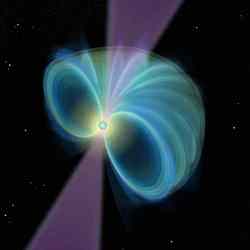
An artist’s impression of a neutron star with its magnetic field lines showing. Image credit: Russell Kightly Media. Click to enlarge
Astronomers of the University of Manchester’s Jodrell Bank Observatory (UK) have led an international team which used the Parkes radio telescope in Australia to find a new kind of cosmic object which sends out radio flashes. These flashes are very short and very rare: one hundredth of a second long, the total time the objects are visible amounts to only about one tenth of a second per day.
The discovery will be published in this week’s issue of the journal Nature.
Eleven sources of flashes have been found in different parts of the plane of the Milky Way in a survey for radio pulsars, which are small, compressed, highly-magnetised, neutron stars that produce regular pulses as they rotate, like cosmic light-houses. While that survey found over 800 pulsars and is the most successful in history, it also uncovered this new type of star. Rather than searching only for the periodic trains of pulses, the astronomers developed new techniques for detecting single short bursts of radiation.
Dr Maura McLaughlin explained: “It was difficult to believe that the flashes we saw came from outer space, because they looked very much like man-made interference”. The isolated flashes last for between 2 and 30 milliseconds. In between, for times ranging from 4 minutes to 3 hours, the new stars are silent.
After confirmation of their celestial nature, studies over the next 3 years revealed that 10 of the 11 sources have underlying periods of between 0.4 seconds and seven seconds.
“The periodicities found suggest that these new sources are also rotating neutron stars, but different from radio pulsars”, says Professor Andrew Lyne. “It is for this reason that we call them Rotating Radio Transients or RRATs. It’s as if, following a flash, a RRAT has to gather its strength during perhaps a thousand rotations before it can do it again !”.
RRATs are a new flavour of neutron stars in addition to the conventional radio pulsars and to the magnetars, which are also believed to be rotating neutron stars and are known to give off powerful X-ray and gamma-ray bursts. It is possible that RRATs represent a different evolutionary phase of neutron stars to or from magnetars.
The new objects probably far outnumber both their cousins. “Because of their ephemeral nature, RRATs are extremely difficult to find and so we believe that there are about 4 RRATs for every pulsar” says Dr Richard Manchester of the Australia Telescope National Facility. He is part of the team which also includes astronomers from the US, Canada and Italy.
Original Source: Jodrell Bank Observatory
